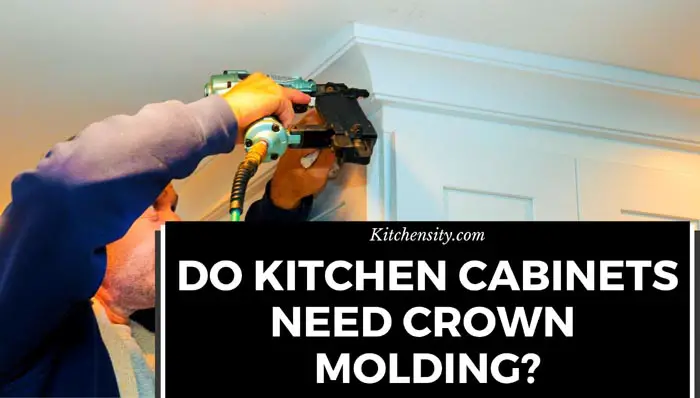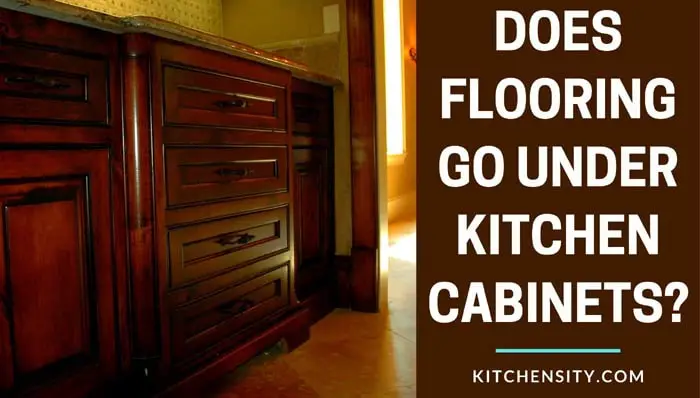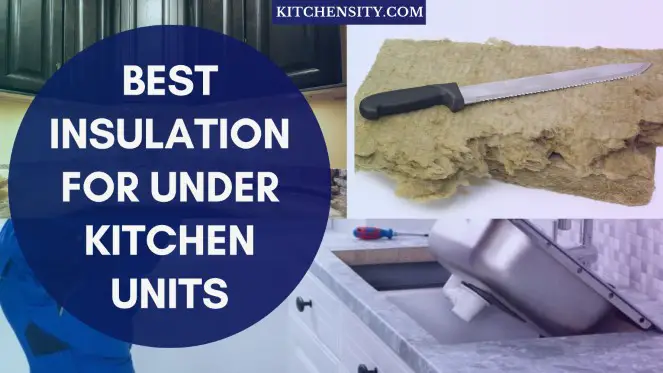If you are looking for ways to improve the aesthetic appeal of your kitchen, then the best way to achieve this is by installing kitchen cabinets crown molding.
The decision to add crown molding to kitchen cabinets is a subjective one that depends on personal taste and the desired aesthetic for the space.
While some prefer the clean and sleek look of cabinets without crown molding, others opt to install them as a means of enhancing the visual appeal and adding a touch of elegance to their kitchen.
In this article, we will explore the question, “Do kitchen cabinets need crown molding?”
We will delve into the benefits of crown molding, installation techniques, various styles available, and considerations to help you make an informed decision about whether crown molding is the right choice for your kitchen cabinets.

Table of Contents
- 1 Do Kitchen Cabinets Need Crown Molding?
- 2 How To Install Crown Molding On Cabinets? (DIY)
- 3 Advanced Process (Step-By-Step)
- 4 Benefits Of Crown Molding
- 5 Cabinets With Crown Molding Vs Without
- 6 Types Of Crown Molding For Kitchen Cabinets
- 7 What Size Crown Molding For Kitchen Cabinets?
- 8 Alternative Uses Of Crown Molding
- 9 Cost Implications Of Installing Crown Molding
- 10 Common Challenges Arising During Installation
- 11 Final Thoughts
- 12 You May Also Like
- 13 FAQ’s
Do Kitchen Cabinets Need Crown Molding?
No, kitchen cabinets do not necessarily need crown molding. It is a matter of personal preference and the desired aesthetic. Crown molding can add a decorative touch and enhance the overall look of the cabinets, but it is not a requirement for all kitchen designs.
Also Read – Is Murphy Oil Soap Good For Kitchen Cabinets?
How To Install Crown Molding On Cabinets? (DIY)
You can install the crown molding on your cabinets by yourself, or you can hire a contractor to do that. It depends on your budget; and how professionally you want to finish the work.
The basic process is to first fix the poplar board on the top of the cabinets, adjust the size, and attach the Bed Molding.
It will be a lot cheaper if you do it by yourself. It will require some materials and tools to do that.
Also Read – How To Draft-Proof Your Under Kitchen Cabinets?
Materials & Tools Required
- Bed Molding (1-5/8-in)
- Poplar Board (3/4-in x 1-1/2-in x 8-ft)
- Nail Hole Filler (DAP DryDex filler)
- Wood Glue
- Sandpaper (220-320 grit) or Sanding Sponge (320 grit)
- Miter Saw
- 18-Gauge Finish Nailer
The sizes for bed molding and poplar board are not fixed. These are the average sizes used for crown molding. You can take the sizes based on your requirements.
Basic Process
Step 1: Fixing The Poplar Board
- First, fix the solid wood mounting strips (poplar board) on the top of the wall cabinets to provide a nailing surface for the crown molding.
- To do that, measure the front and sides of the cabinets and then cut the wood strips according to the required sizes.
- After that, apply glue to each poplar and nail to fix them in their place, and let them dry.
Step 2: Fixing The Bed Molding
This step is crucial as you have to adjust the crown molding corners to look appealing.
- First, measure the front side of the cabinet and then cut the bed molding 3 inches oversize because you have to adjust the corners and cut them at a 45-degree angle.
- Similarly, measure the sides and cut the pieces by leaving 2 inches oversize. This will help you to match the corners perfectly. (Bring 2-3 pieces extra because you can make mistakes here).
- Now, glue the pieces and carefully fix them to the wood strip. Align the edges and bottom properly, and finally, fix them by nailing.
Step 3: Finishing The Bed Molding Installation
Apply the nail hole filler to fill the nail holes and any gaps at the corners, and finally, smooth the surface with the 320-grit sanding sponge. After that, apply two coats of primer and paint them to match the cabinet’s finish.
With these three steps, you can install crown molding on your cabinets.
Also Read – How To Stop A Draught From Behind Kitchen Cupboards?
Advanced Process (Step-By-Step)
Installing crown molding on kitchen cabinets requires careful attention to detail and precise execution. Here is a step-by-step guide accompanied by tips and techniques to help ensure a successful installation:
Materials And Tools Required
- Crown molding
- Measuring tape
- Miter saw
- Coping saw or miter saw for corners
- Adhesive or finishing nails
- Caulk
- Sandpaper or sanding sponge
- Paint or stain (optional)
Step 1: Measure And Plan
- Measure the length of each section of the cabinet where the crown molding will be installed. Add a few extra inches to account for mitered or coped corners and any potential errors.
- Plan the layout and determine the orientation of the crown molding pieces, ensuring they fit together seamlessly.
Step 2: Cut The Crown Molding
- Use a miter saw to cut the crown molding pieces according to your measurements and the desired angle for corners. Remember to cut the molding upside down and backward for accurate angles.
- For inside corners, use a coping saw or a miter saw set to a 45-degree angle to cut along the profile of the molding for a clean fit.
Step 3: Dry Fit The Crown Molding
- Dry fit the crown molding pieces on top of the cabinets to check the accuracy of the cuts and ensure they fit together properly. Make any necessary adjustments to the cuts if needed.
Step 4: Secure The Crown Molding
- Apply adhesive to the back of the crown molding or use finishing nails to secure it to the top of the cabinets. The adhesive is often sufficient for lightweight molding, while nails provide additional support for heavier pieces.
- Place nails strategically, ensuring they penetrate the cabinet framing and studs for a secure attachment. Avoid nailing through the front of the molding to maintain a clean finish.
Step 5: Fill And Sand
- Fill any gaps or nail holes with caulk or wood filler, smoothing them out with a putty knife. Allow the filler to dry, then sand the surface with sandpaper or a sanding sponge to achieve a smooth and seamless finish.
Step 6: Finishing Touches
- Apply a coat of paint or stain to match the crown molding with the rest of the cabinets, if desired. Allow the finish to dry completely before proceeding.
Tips And Techniques
- When measuring, double-check your measurements and take into account any variations in ceiling height or cabinet dimensions.
- Make test cuts on scrap pieces of crown molding to ensure accurate angles and proper fit before cutting the actual molding.
- For inside corners, coping the crown molding helps achieve a tighter and more precise fit.
- Use a miter saw stand or create a jig to support longer pieces of crown molding during cutting to ensure accuracy.
- Secure the crown molding with adhesive in addition to nails for added stability and to prevent any gaps between the molding and cabinets.
- Pre-drill pilot holes before nailing to prevent splitting the molding.
- Use caulk or wood filler to fill any small gaps or imperfections, creating a seamless and professional finish.
- Take your time and work carefully to ensure a precise and aesthetically pleasing installation.
Also Read – Why Are My Kitchen Cupboards So Cold?
Benefits Of Crown Molding
Elaborating on the benefits of crown molding for kitchen cabinets will provide readers with a deeper understanding of why it is worth considering. Here are some points to expand upon:
- Enhanced Aesthetic Appeal:
- Crown molding can significantly enhance the overall aesthetic appeal of kitchen cabinets.
- It adds a touch of elegance and sophistication, giving your kitchen a more upscale and finished look.
- The decorative nature of crown molding brings visual interest and can elevate the style and ambiance of the space.
- Seamless Transition:
- One of the key benefits of crown molding is its ability to create a seamless transition between the upper cabinets and the ceiling.
- It eliminates the unsightly gaps that may exist between the cabinets and the ceiling, providing a more polished and cohesive appearance to the kitchen.
- This seamless transition gives the impression of custom-built cabinets and enhances the overall visual harmony of the room.
- Hiding Imperfections:
- Crown molding can be an effective solution for hiding imperfections or uneven lines where the cabinets meet the ceiling.
- It covers any gaps or inconsistencies in a visually appealing manner, making the transition between the cabinets and the ceiling appear flawless.
- This can be particularly beneficial in older homes or kitchens with irregular ceiling heights.
- Design Versatility:
- Crown molding comes in various styles, sizes, and designs, allowing you to choose the one that best complements your kitchen’s overall style.
- Whether you prefer a traditional, modern, or transitional look, there is a crown molding option available to suit your preferences.
- You can select from different profiles, finishes, and decorative details to achieve the desired aesthetic effect.
- Personalization And Customization:
- Crown molding offers an opportunity for personalization and customization.
- It allows you to add a unique touch to your kitchen design by selecting a crown molding style that reflects your taste and complements your cabinetry.
- The right choice of crown molding can become a defining feature of your kitchen, adding character and charm to the space.
- Increased Resale Value:
- Installing crown molding on kitchen cabinets can potentially increase the resale value of your home.
- Many homebuyers appreciate the added elegance and attention to detail that crown molding brings to a kitchen.
- It can be a selling point that sets your kitchen apart from others and leaves a positive impression on potential buyers.
Also Read – Best Insulation for Under Kitchen Units
Cabinets With Crown Molding Vs Without
When it comes to kitchen cabinets, the addition of crown molding can significantly impact the overall look and feel of the space.
Let’s compare the differences between cabinets with crown molding and cabinets without crown molding:
Aesthetic Appeal
- Cabinets With Crown Molding:
- Crown molding adds a touch of elegance, sophistication, and architectural detail to kitchen cabinets.
- It enhances the visual appeal of the cabinets, creating a polished and finished look.
- Crown molding can make a kitchen feel more upscale and luxurious, elevating the overall aesthetic of the space.
- Cabinets Without Crown Molding:
- Without crown molding, cabinets have a simpler and more minimalist appearance.
- This can work well in contemporary or modern kitchen designs that favor clean lines and a sleek aesthetic.
- Cabinets without crown molding provide a more understated and streamlined look.
Seamless Transition
- Cabinets With Crown Molding:
- One of the key benefits of crown molding is its ability to create a seamless transition between the cabinets and the ceiling.
- It covers any gaps or imperfections that may exist, giving the cabinets a more integrated and cohesive look.
- Crown molding can provide a finishing touch that completes the overall design of the kitchen.
- Cabinets Without Crown Molding:
- Without crown molding, there may be a visible gap between the cabinets and the ceiling.
- This gap can sometimes collect dust and become difficult to clean.
- However, in some design styles, leaving the space open between the cabinets and the ceiling can create a more open and airy feel in the kitchen.
Design Flexibility
- Cabinets With Crown Molding:
- Crown molding offers a wide range of styles and designs to choose from, allowing for customization and creativity.
- Traditional crown molding features intricate details and decorative elements, while stepped, stacked, or light molding options can provide a more contemporary or transitional look.
- With crown molding, you have the flexibility to select a style that complements the overall design theme of your kitchen.
- Cabinets Without Crown Molding: Cabinets without crown molding may have a simpler and more uniform appearance. While this can work well in certain design styles, it may not offer as much design versatility or the opportunity to add architectural interest to the kitchen.
Also Read – How to Insulate Under Kitchen Cabinets?
Types Of Crown Molding For Kitchen Cabinets
When it comes to crown molding for kitchen cabinets, there are various types and designs to choose from.
Each type of crown molding has its characteristics and features that can enhance the overall aesthetic appeal of your kitchen.
Here are some common types of crown molding for kitchen cabinets:
- Traditional Crown Molding:
- Traditional crown molding features intricate details and ornate designs.
- It typically has a curved profile and decorative motifs such as scrolls, dentil molding, or floral patterns.
- Traditional crown molding adds a touch of elegance and classic charm to kitchen cabinets, making it a popular choice for traditional or formal kitchen designs.
- Stepped Crown Molding:
- Stepped crown molding, also known as layered or tiered crown molding, consists of multiple layers or steps.
- Each layer is set back slightly, creating depth and visual interest.
- Stepped crown molding offers a modern twist to traditional crown molding and works well in transitional or contemporary kitchen designs.
- Stacked Crown Molding:
- Stacked crown molding involves layering multiple pieces of molding on top of each other.
- It creates a bold and substantial look, adding dimension and architectural flair to kitchen cabinets.
- Stacked crown molding can be achieved by combining different crown molding profiles or using crown molding with built-in decorative elements.
- Lighted Crown Molding:
- Lighted crown molding incorporates lighting elements into the molding itself.
- It can include LED strips or recessed lighting to provide ambient or task lighting in the kitchen.
- Lighted crown molding not only adds a decorative touch but also serves a functional purpose by illuminating the countertop or workspace below the cabinets.
- Shoe Molding:
- Shoe molding is a smaller-sized molding that is typically installed at the bottom edge of the crown molding.
- It provides a finished look and covers any gaps between the crown molding and the cabinets.
- Shoe molding can add a subtle accent and create a seamless transition between the crown molding and the cabinets.
- Simple Or Flat Crown Molding:
- Simple or flat crown molding features a clean and straightforward design without intricate details or decorative elements.
- It offers a minimalist look and works well in modern or contemporary kitchen designs.
- Simple crown molding can provide a clean finish and a subtle frame to the cabinets without overpowering the overall design.
When choosing the type of crown molding for your kitchen cabinets, consider the style and theme of your kitchen, as well as your personal preferences.
You can consult with a professional or browse through design catalogs and online resources to find the crown molding style that best suits your kitchen’s aesthetic and complements the overall design of the space.
Also Read – Effective Ways To Update Old Kitchen Cabinets [Under $100]
What Size Crown Molding For Kitchen Cabinets?
The size of crown molding for kitchen cabinets can vary depending on several factors, including the style of your kitchen, the height of the cabinets, and your personal preferences.
However, some general guidelines can help you determine the appropriate size of crown molding for your kitchen cabinets. Here are some considerations:
- Proportions: The size of the crown molding should be proportionate to the size of the cabinets and the overall scale of the kitchen. Large cabinets or kitchens with high ceilings can accommodate larger crown moldings, while smaller cabinets or kitchens may benefit from smaller or narrower moldings.
- Ceiling Height:
- The height of the crown molding is often a matter of personal preference.
- The most common height for crown molding in kitchens is 2 to 3 inches. This size provides a balanced look and allows for a seamless transition between the cabinets and the ceiling.
- However, you can opt for taller crown moldings, such as 4 or 5 inches, if you want to make a more dramatic statement or if you have higher ceilings.
- Cabinet Style: Consider the style of your kitchen cabinets when selecting the size of the crown molding. Traditional or ornate cabinet styles may pair well with larger crown moldings, while sleek and modern cabinet styles might be better suited to narrower or simpler moldings.
- Visual Impact: Think about the visual impact you want to achieve with the crown molding. Larger moldings can create a more substantial and decorative look, drawing attention to the upper portion of the cabinets. Smaller moldings, on the other hand, provide a more subtle and understated touch.
It’s important to note that these are general guidelines, and ultimately, the choice of crown molding size is subjective and based on personal preference. It’s a good idea to experiment with different sizes and consider mock-ups or samples before making a final decision.
Additionally, consulting with a professional or seeking advice from an interior designer can help you choose the appropriate size of crown molding that best suits your kitchen cabinets and enhances the overall aesthetic appeal of your kitchen.
Also Read – Can You Put Kitchen Cabinets On Top Of Vinyl Plank Flooring?
Alternative Uses Of Crown Molding
Crown molding is not limited to its traditional use on kitchen cabinets. Its versatility allows for creative and unique applications in various areas of the kitchen.
Here are some alternative uses of crown molding to consider:
- Island Accents:
- Crown molding can be used to add a decorative touch to the sides or edges of a kitchen island.
- By installing crown molding along the base or top edges of the island, you can create a visually appealing and cohesive look.
- This application helps to elevate the island’s design and make it a focal point in the kitchen.
- Range Hood Enhancement:
- Adding crown molding around a range hood can transform it into a stylish and sophisticated feature.
- By installing crown molding along the edges or top of the range hood, you can give it a more finished and integrated appearance.
- This application complements the overall design of the kitchen and creates a cohesive look with the cabinets.
- Open Shelving Borders:
- If you have open shelving in your kitchen, crown molding can be used to define and frame the shelves.
- By installing crown molding along the edges of the shelves, you can add a touch of elegance and provide a finished look.
- This application is particularly effective in kitchens with a more traditional or classic design.
- Window And Door Casings:
- Crown molding can also be used as a decorative casing for windows and doors in the kitchen.
- By installing crown molding around the window or door frames, you can create a more refined and polished look.
- This application helps to add architectural interest and complements the overall design theme of the kitchen.
- Ceiling Medallions:
- Crown molding can be combined with a ceiling medallion to create a stunning focal point in the kitchen.
- By installing a medallion in the center of the ceiling and adding crown molding around it, you can create a captivating design element.
- This application works particularly well in kitchens with higher ceilings, adding elegance and visual interest.
- Wainscoting Or Chair Rail:
- Crown molding can be used as part of wainscoting or chair rail installations in the kitchen.
- By combining crown molding with other decorative trims, you can create a sophisticated and stylish look along the walls.
- This application adds architectural detail and can enhance the overall character of the kitchen.
Also Read – How To Cut Down Kitchen Cabinets?
Cost Implications Of Installing Crown Molding
Cost considerations are essential when deciding to install crown molding on kitchen cabinets. Here’s an overview of the cost implications, including estimated price ranges for materials and tools, as well as considerations for DIY projects and professional installation:
DIY Project Costs
- Crown Molding Materials: The cost of crown molding varies depending on the type of material chosen, such as wood, medium-density fiberboard (MDF), or polyurethane. On average, crown molding can range from $1 to $10 per linear foot. The total cost will depend on the length of molding required for your cabinets.
- Additional Materials: In addition to crown molding, you will need adhesive, finishing nails, caulk, sandpaper, and paint or stain. These materials can cost approximately $20 to $50, depending on the quality and quantity needed.
- Tools: If you don’t already have the necessary tools, such as a miter saw, coping saw, nail gun, and sanding tools, you may need to purchase or rent them. The cost of tools can range from $100 to $300, depending on the brand and quality.
Professional Installation Costs
- Labor Costs: Hiring a professional to install crown molding on kitchen cabinets will involve labor costs. The price can vary based on the complexity of the project, the region, and the experience of the professional. On average, professional installation costs can range from $5 to $15 per linear foot, including materials.
- Additional Costs: Professionals may charge extra for materials, transportation, and any necessary finishing work, such as caulking, filling gaps, and painting. These additional costs should be discussed and agreed upon before hiring the professional.
Budget-Friendly Options
- Alternative Materials: If budget is a concern, consider using more affordable materials such as MDF or polyurethane crown molding instead of solid wood. These options can offer a similar look at a lower cost.
- DIY Installation: Opting for a DIY installation can save on labor costs. By following the step-by-step instructions provided and utilizing online resources or video tutorials, you can achieve professional-looking results at a fraction of the cost.
- Pre-Finished Crown Molding: Choosing pre-finished crown molding eliminates the need for painting or staining, reducing both material and labor costs.
- Consider Partial Installation: If you have limited funds, consider installing crown molding on select areas of the kitchen cabinets, such as the upper cabinets or the focal point area. This allows you to achieve a visually appealing look while minimizing the overall cost.
It’s important to note that the cost estimates provided are rough ranges and can vary depending on factors such as the region, quality of materials, and individual preferences.
It’s recommended to research local prices and consult with suppliers or professionals to get accurate estimates based on your specific project requirements.
Also Read – How To Repair Chipped Paint On Kitchen Cabinets?
Common Challenges Arising During Installation
When considering crown molding for kitchen cabinets, several common challenges or concerns may arise.
It’s important to address these issues and provide solutions or alternative approaches to help readers overcome them effectively.
Here are some common challenges and ways to address them:
1. Limited Ceiling Height:
- If you have limited ceiling height, consider using smaller-sized crown molding to ensure it doesn’t overwhelm the space.
- Opt for crown molding styles that are less intricate and have a lower profile, as they can create a visually pleasing effect without taking up too much vertical space.
- Install the crown molding slightly lower on the cabinets, leaving more space between the molding and the ceiling. This can create the illusion of higher ceilings.
2. Angled Or Sloped Ceilings:
- When dealing with angled or sloped ceilings, it’s important to carefully measure and cut the crown molding to match the angle of the ceiling.
- Use a miter saw with adjustable angles to accurately cut the molding to fit the slope of the ceiling.
- Consider using flexible crown molding made from materials such as polyurethane, which can be bent and shaped to accommodate angled or sloped ceilings more easily.
3. Uneven Walls:
- Uneven walls can pose challenges when installing crown molding. It’s crucial to ensure a tight fit against the wall to achieve a polished look.
- Use a scribe tool or contour gauge to trace the profile of the wall onto the back of the crown molding. This allows you to cut and shape the molding to fit precisely against the uneven wall.
- Consider using a backer board or shimming behind the crown molding to level out any significant irregularities in the wall surface.
4. Concealing Gaps Or Imperfections:
- To address gaps between the crown molding and the ceiling or walls, use caulk or wood filler to fill in the spaces and create a seamless appearance.
- Sand down any rough edges or imperfections on the crown molding before applying paint or stain to achieve a smooth finish.
- Consider using crown molding with a larger profile or adding decorative elements to the design to draw attention away from any minor imperfections.
5. Alternative Approaches:
- If traditional crown molding installation proves challenging, consider using other molding or trim options that provide a similar aesthetic appeal. Examples include shoe molding, light rail molding, or stacked molding.
- Explore the possibility of using faux or adhesive crown molding. These alternatives can be easier to install and are often more affordable, while still achieving a similar visual effect.
Also Read – Can You Use Loft Insulation Under Kitchen Cabinets?
Final Thoughts
In conclusion, the decision of whether kitchen cabinets need crown molding ultimately comes down to personal preference and the desired aesthetic for your space.
While crown molding can add a touch of elegance and sophistication, enhancing the overall visual appeal of your kitchen cabinets, it is not a necessity for every kitchen design.
By considering the benefits, exploring different styles, understanding the installation process, and addressing common challenges, you can make an informed decision that aligns with your taste and budget.
Whether you choose to crown your cabinets or leave them without molding, the goal is to create a kitchen that reflects your style and brings you joy every time you step into the room.
You May Also Like
- What Can I Put Under My Kitchen Sink to Protect My Cabinets?
- Refacing Kitchen Cabinets: An Ultimate DIY Guide
- Replace Kitchen Cabinets Without Replacing Countertop
- Chalk Paint Vs Latex Vs Regular Paint For Kitchen Cabinets
- How To Update Old Kitchen Cabinets?
- Does Flooring Go Under Kitchen Cabinets?
FAQ’s
-
Do Modern Kitchens Have Crown Molding?
If you are installing contemporary kitchen cabinets, then no need to install crown molding. They favor a simple look, and you will not notice any decorative trim or faux finishes.
Instead of any decorative pieces, the contemporary cabinets have flat surfaces with sleek and simple hardware. So, not all modern kitchen cabinets have crown molding. -
What Type Of Molding Is Best For The Top Of Cabinets?
Crown molding is best for the top of the cabinets. In crown molding, there are various options like traditional, stepped, stacked, light, shoe molding, etc.
-
How Do You Fill The Gap Between Kitchen Cabinets And Ceiling?
The best way to fill the gap between the kitchen cabinets and the ceiling is to install crown molding. They will look appealing as well as fill the unnecessary gaps.
-
Is Crown Molding Worth It?
Yes, crown molding is worth it. It is a decorative trim or piece of wood that is added to the top of your cabinets. It will draw your guest’s eyes upward when they visit your kitchen by showcasing its elegant beauty.
You can either fill the gaps between the cabinets and the ceiling or leave the space between them. Both ways are fine and look great. -
Is Crown Molding Going Out Of Style?
No, crown molding can’t go out of style. It will be present for many years. The fact is that some people like the basic and simple look and some like decoration.
That’s why contemporary kitchen cabinets offer a simple and sharp look while other cabinets still need crown molding.
Katrina Smith is a seasoned expert with over 25 years of experience in all things related to cooking and the kitchen. As an avid cook and kitchen enthusiast, she is passionate about sharing her knowledge and expertise on cookware, kitchen appliances, kitchen tips, and kitchen staples.
Through her articles and reviews, Katrina aims to inspire and help others improve their cooking skills, experiment with different ingredients, and invest in quality cookware and appliances.

![3 Effective Ways To Update Old Kitchen Cabinets [Under $100] 3 How To Update Old Kitche Cabinets](https://www.kitchensity.com/wp-content/uploads/2021/05/How-To-Update-Old-Kitche-Cabinets.jpg)
![Refacing Kitchen Cabinets: An Ultimate DIY Guide [2023] 4 Refacing Kitchen Cabinets](https://www.kitchensity.com/wp-content/uploads/2021/05/Refacing-Kitchen-Cabinets.jpg)



